Hey There!
I'm Reina
I am a full-time traveling registered nurse, fitness enthusiast, and nutrition expert. Every morning I wake up intending to bring awareness of the importance of health and spiritual wellness, especially to the traveling community. At Messy Bun Traveler, we promote travel that allows the traveler to either kick-start, maintain, or enhance a healthy lifestyle. So whether you're someone who travels for business, travels for pleasure, or new to travel and looking for health advice while on the road, this blog is for you!
inspiration
Categories:
health
destinations
fitness
resources
wellness
Privacy & Disclosure
The Messy Bun Traveler is designed to bring you fun stories, destination guides, and healthy travel advice. To help cover the cost of running this site, all posts are sprinkled with hand-selected affiliate links. When you click on one of these links and make a purchase, I will earn a small commission at no additional cost to you. I only accept affiliate links and paid advertisements from brands I believe in, trust and use personally. Thank you for your continued support!
Peruvian Superfoods You Must Try!
March 20, 2022
What makes a superfood so super? I mean, the term itself has only been utilized within the food industry for the last few years.
As there’s no definitive definition of what makes a superfood a “superfood,” it commonly describes foods rich in compounds (vitamins, minerals, fiber, etc.) vital to a person’s health.
There’s no denying that the country of Peru has a plethora of these highly nutritious food options. After all, Peru contains 28 of the 32 climatic zones of the world, allowing it to harvest a variety of out-of-this-world produce!
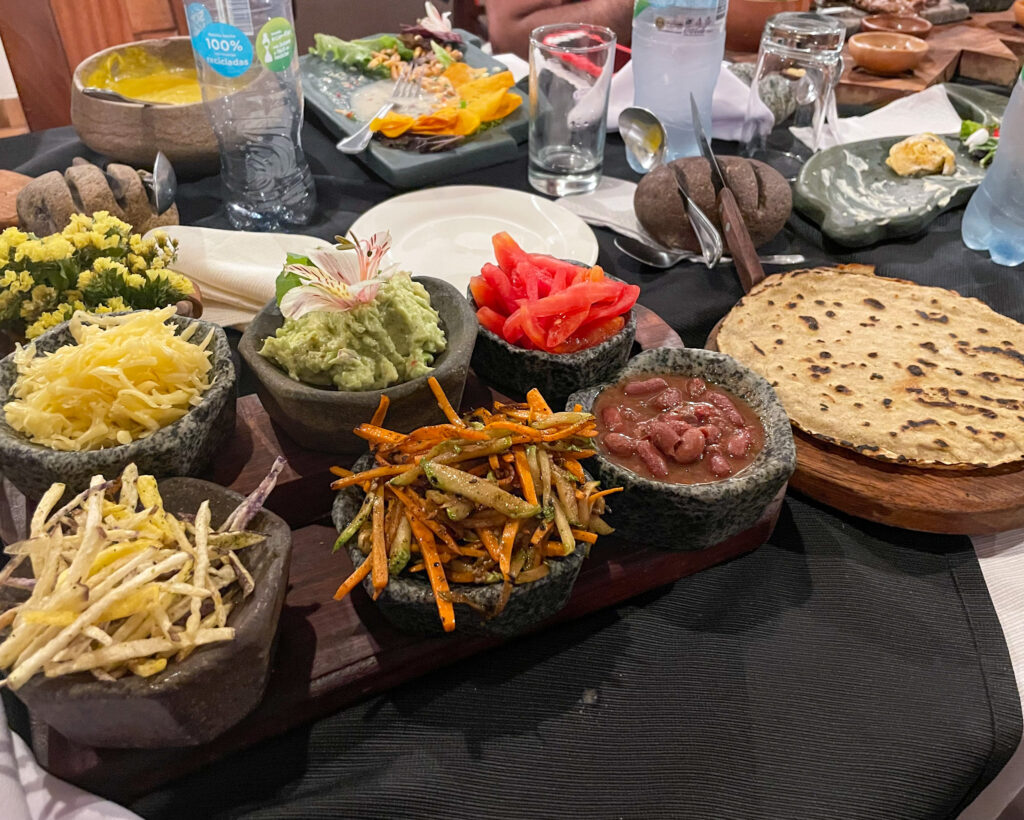
Peru is a great foodie’s destination. I loved the variety of cuisines, spices, and dishes bursting with flavor. I never felt guilty indulging in all the restaurants – I knew the food was freshly prepared and utilized many healthy ingredients!
Here’s a list of Peruvian superfoods that can spice up your palate and contribute to your overall health and wellbeing!
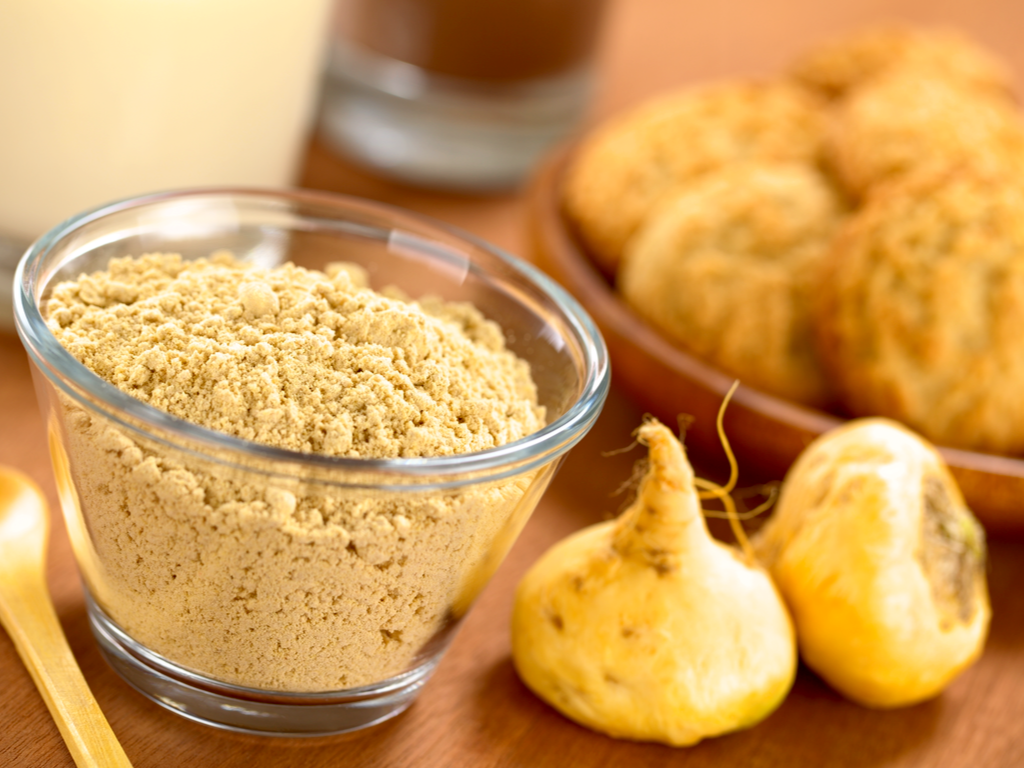
Maca Root
Believe it or not, I learned about the health benefits of maca root several years ago when I first became interested in nutrition and types of superfoods.
I was pleasantly surprised when I realized that maca actually comes from the Junin region of Peru, an area high in altitude – between 12,400 and 14,700 feet!
Maca is a cruciferous vegetable nicknamed the “Peruvian ginseng.” It’s shown to positively affect physical stamina, endurance, and even your libido.
It’s considered a natural energy source of the Incas and today is consumed worldwide! It’s one of the most widely used Peruvian superfoods on this list!
What it Tastes Like:
Maca root has a robust flavor, so a little goes a long way. It has an earthy, slightly nutty taste with a hint of sweetness.
It’s often used in plant-based smoothies and recipes as it gives a slight butterscotch flavor.
Nutrition Facts:
Maca root is rich in healthy carbohydrates and alkaloids. It’s also an excellent source of plant-based protein, fiber, essential amino acids, and fatty acids.
It incorporates vitamins and minerals like:
- Thiamin (B1): helps the body convert carbohydrates into energy.
- Riboflavin (B2): essential for more red blood cell production
- Vitamin C: a powerful antioxidant for the immune system
- Niacin: supports healthy circulation in the body
- Calcium: great for strong bones and healthy teeth! Believe it or not, maca contains more calcium than milk!
- Magnesium: essential for building proteins in the body and for muscle and nerve activity. Also crucial for heart health, quality sleep, and relaxation.
- Others: phosphorus, potassium, sodium, copper, zinc, manganese, iron, selenium, and boron.
Health Benefits:
Maca root falls in the adaptogens category. Adaptogens are a group of herbs, plants, and mushrooms that increase your body’s ability to deal with varying stressors.
They help our body maintain homeostasis and build resilience even when our outside environment constantly changes.
In addition to being an adaptogen, maca root contains sterols, a substance known to help lower cholesterol.
The Peruvians have been using this superfood for thousands of years for its aphrodisiac properties and increased fertility. However, these claims are still being studied.
In a nutshell, maca is a Peruvian superfood because it works by balancing your body’s endocrine system to decrease fatigue, increase energy, and balance mood and feelings of wellbeing.

Enjoying a delicious maca smoothie!
How to Use It:
I love using maca root in smoothies! It also tastes great in your morning oatmeal as it gives a delicious butterscotch flavor when cooked.
See also:
Where to Try it While in Peru:
While visiting Peru, many street vendors sell maca root in powder form. I saw it everywhere while walking the streets of Lima. You’ll also be able to find it in local cafés and smoothie shops.
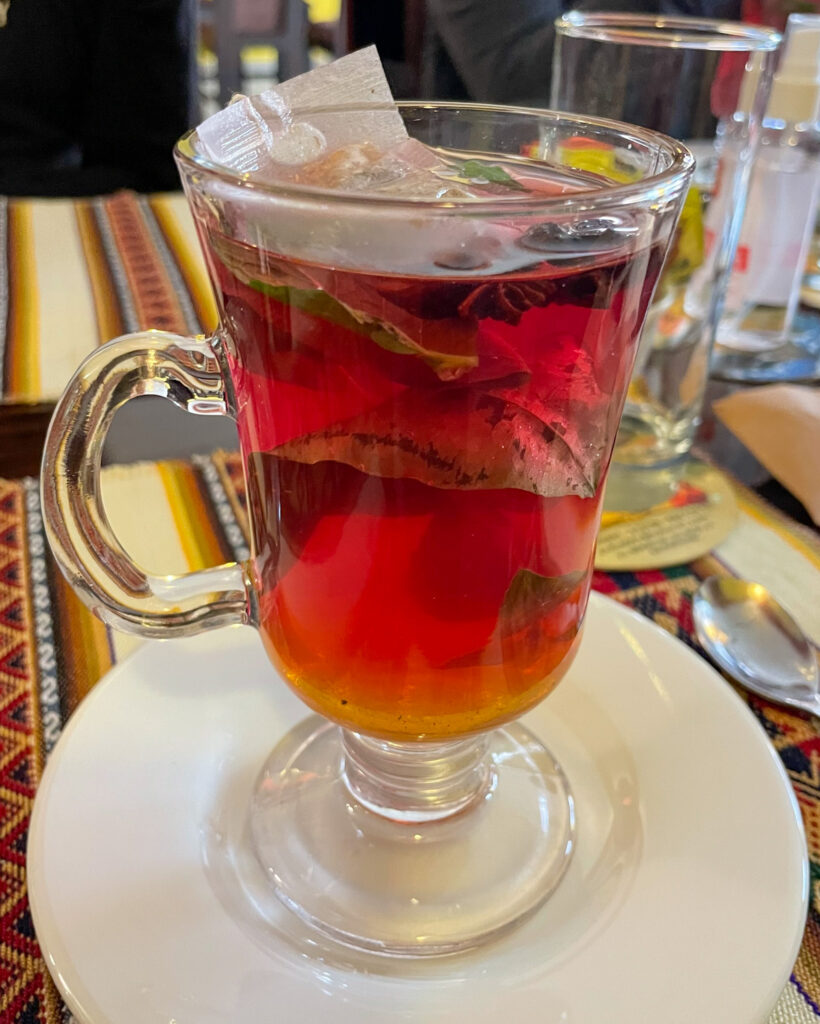
Yummy hibiscus & coca leaves tea
Coca Leaves
The coca plant is grown all other the country of Peru and its neighboring countries of Brazil, Bolivia, and Colombia.
Today, it is widely known for its use in the production of cocaine. However, the leaves themselves are a powerful Peruvian superfood used by the Incans for centuries as a common health food staple.
This plant plays a considerable role in the cultural and spiritual history of the Andean culture. It was even used by the Incans when constructing the magnificent Machu Picchu!
What it Tastes Like:
When I first tried coca leaves, it left a very bitter and earthy taste in my mouth. It’s not the most pleasant, but it makes the tongue and cheeks numb, which is a fun feeling. Like a trip to the dentist!
Nutrition Facts:
Coca leaves are a good source of protein and essential amino acids. It contains a small amount of fiber, and a long list of vitamins and minerals, like:
- Beta-carotene: great for vision and overall eye health. Also has positive effects on the body’s immune system.
- Vitamin E: a mighty antioxidant important for vision, reproduction, skin, and the brain.
- Vitamin D: the maintenance of healthy bones and teeth!
- Calcium
- Iron: mineral needed in the body to make hemoglobin, a protein in red blood cells needed to carry oxygen to the body.
- Zinc: helps the immune system and your body’s metabolism
- Magnesium: essential for building proteins in the body and for muscle and nerve activity. Also crucial for heart health, quality sleep, and relaxation.
Health Benefits:
While the indigenous people of Peru used coca leaves for various ailments, today, it is widely used by tourists to help elevate headaches associated with altitude sickness.
It also helps increase energy, improves mood, and acts as an appetite suppressant.
How to Use It:
You’ll see coca leaves either brewed in teas or dried and chewed straight.
I learned from my tour guide that the best way to get the full benefits of coca is to chew it will a catalyst, most often ashes from the quinoa plant, and then just leave it in the cheek.
When a catalyst is added, the alkaloid properties from coca is released. And by forming a quid in the cheek, you’re left to absorb the juices and the coca’s benefits.
It’s a plant that produces a mild euphoria, similar to the kava root from Fiji. To me, the effects felt like the equivalent of drinking about 3 cups of coffee. I was undoubtedly more alert, talkative, and energetic. I did feel a slight crash afterward.
Coca leaves are not only a Peruvian superfood, but it’s also a sacred ceremonial tool. It’s used as an offering to Mother Earth to wish for good fortune, forgiving weather, and show gratitude to the gods.
*Disclaimer: because of the concern with cocaine production, coca leaves are illegal to bring to the United States and many other countries in the world. Even in certain parts of Peru, it’s illegal to cultivate and sell coca leaves.
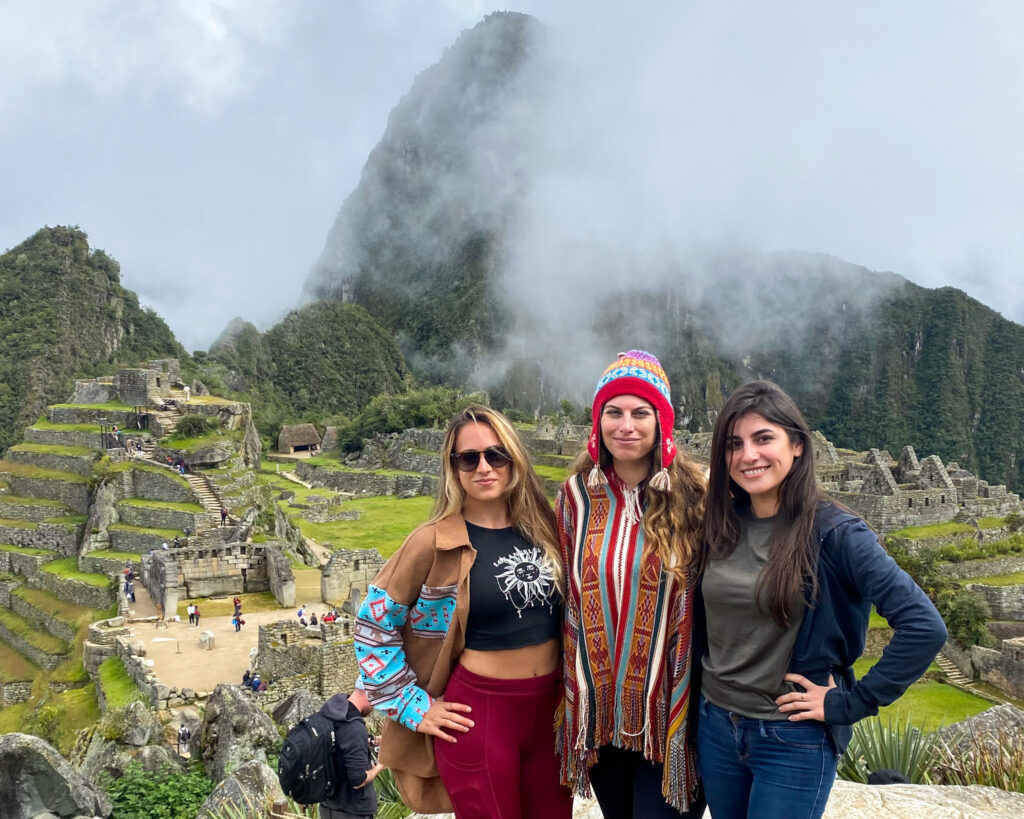
Trying coca leaves in the cheek at Machu Picchu
Where to Try it While in Peru:
If you are in Peru, you’ll find coca leaves while traveling to Cusco. Most street vendors will have bags of coca leaves to sell, costing about 2-3 soles.
See also:
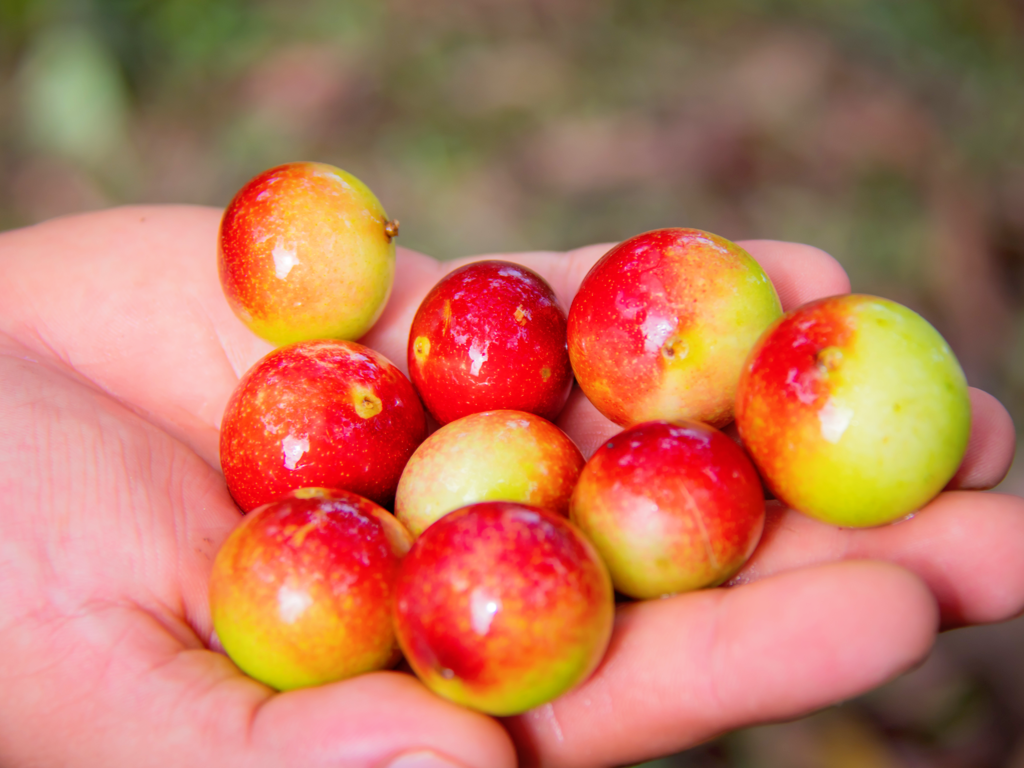
Camu Camu
Camu camu is a fruit indigenous to the swampy terrain of the Amazon Jungle in Peru.
Camu camu is a Peruvian superfood because it’s long been utilized to fight viral infections, including the common cold, hardening of the arteries, chronic fatigue, and more.
In fact, it’s famous for being one of the highest vitamin C-rich foods on the planet! It’s a red/purple berry that’s slightly smaller than your more commonly known cherry.
See also:
What it Tastes Like:
This berry is tart! Almost sour enough to be comparable to lime or lemon, you’ll probably never consume this berry raw.
Nutrition Facts:
Camu camu contains powerful phytochemicals, compounds with protective and disease preventative characteristics.
They also have amino acids, a small amount of protein, and some healthy fats. Its vitamins and minerals include:
- Vitamin C: immune system booster and liver detoxifier
- Manganese: essential in supporting overall bone health and preventing diabetes
- Copper: for maintaining nervous system and immune health. It also helps in the formation of collagen and iron absorption.
- Iron: mineral needed in the body to make hemoglobin, a protein in red blood cells needed to carry oxygen to the body.
- Others: magnesium, calcium, potassium, and zinc
Health Benefits:
The camu camu fruit is known to have many health benefits, including maintaining a healthy immune system, promoting gut health, and even liver health.
Since it’s so high in vitamin C, it helps you recover from ailments like the flu and common colds and is vital for optimal gut health.
See also:
How to Use It:
Camu camu is most popularly consumed in powder form since the fruit itself is too sour to eat. This powder can be added to anything: from smoothies to morning oatmeal and even ice cream.
Where to Try it While in Peru:
You can easily find this Peruvian superfood in most markets. It’ll be sold either raw or in various tasty treats like smoothies and ice cream.
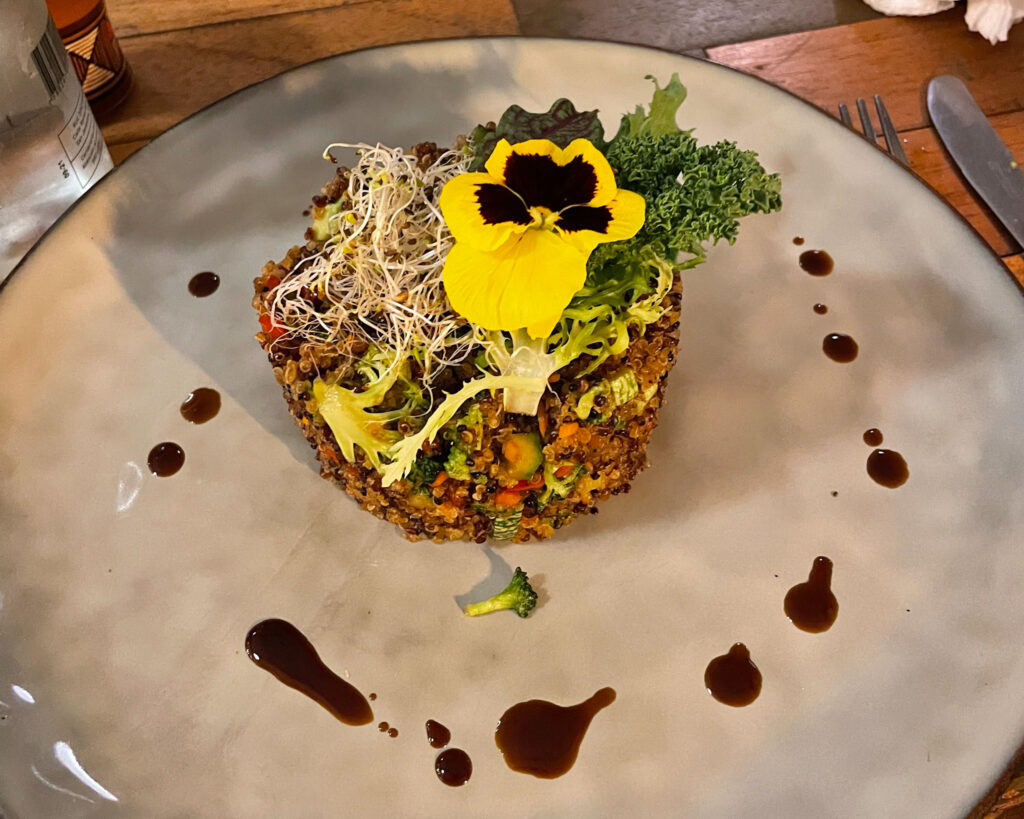
Quinoa
Quinoa is one of the more well-known Peruvian superfoods out there. It’s one of the few plant-based protein food sources containing all nine essential amino acids, is an excellent source of fiber and complex carbohydrates, and can easily be incorporated into any dish.
Peruvians have been reaping the benefits of this gluten-free seed for thousands of years. In many restaurants I visited while in Peru, quinoa is served and prepared in various ways. All incredibly tasty!
What it Tastes Like:
With a texture very similar to couscous, quinoa tastes much like a nutty brown rice. It’s very subtle, and what’s nice about quinoa is that it can take on any flavor it’s cooked with.
Nutrition Facts:
Quinoa is mainly composed of healthy carbohydrates, fiber, and protein. It has a good source of antioxidants and minerals, including:
- Manganese: utilized for metabolism, growth, and development
- Phosphorus: a mineral important for bone health and the maintenance of many bodily tissues.
- Copper: important for a healthy heart.
- Folate: essential for cell function and tissue growth (very important in pregnant women!)
- Others: iron, magnesium, and zinc.
Health Benefits:
Quinoa is highly nutritious! On top of providing the body with many vitamins and minerals, quinoa is also good for lowering blood sugar levels, lowering triglycerides, and even improving brain function.
How to Use It:
Quinoa can be utilized in many dishes, as it’s an excellent substitute for rice. It even can be used in place of rolled oats for a delicious alternative to breakfast oatmeal.
Use it in salads, Buddha bowls, and more!
Where to Try it While in Peru:
Although quinoa can be found in restaurants all over Peru, I had the best quinoa dishes in Cusco! The quinoa is cooked in a melody of flavors and vegetables. My mouth is watering just thinking about it!
See also:
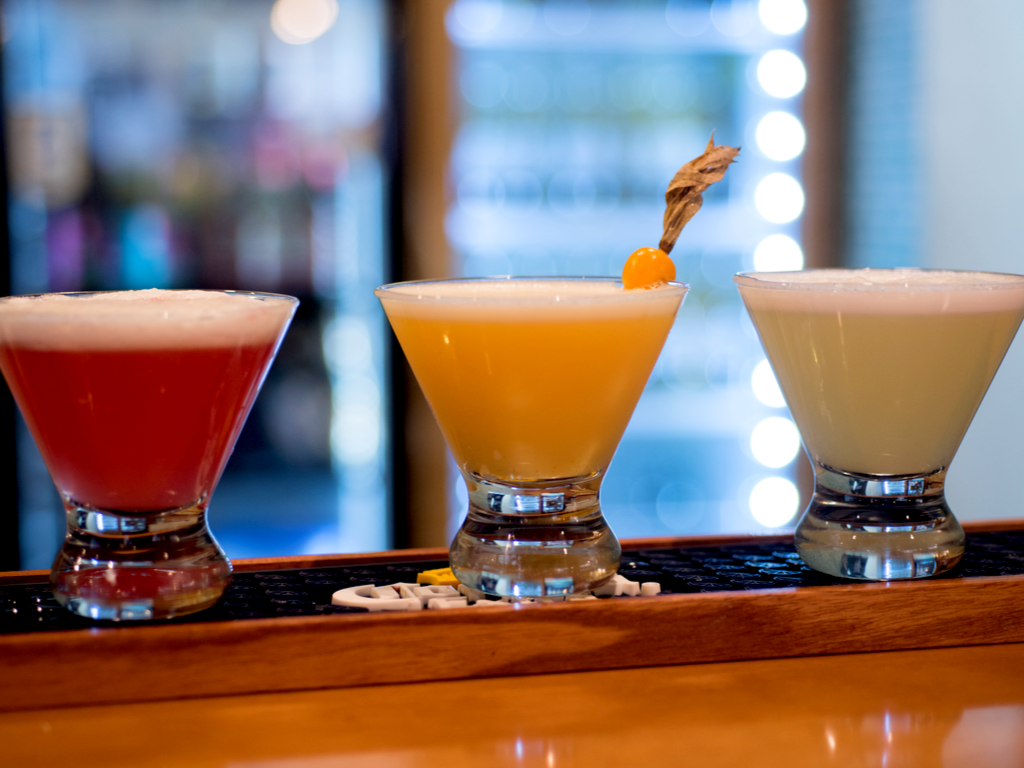
Goldenberry (or the Inca Berry)
The goldenberry, also known as the Inca Berry or the Goji Berry of South America, is another Peruvian superfood. It makes for a great snack or fun addition to your evening cocktail.
In fact, the first time I came across this berry was at a nightclub in Cusco when it was beautifully displayed in my pisco sour.
What it Tastes Like:
Surprisingly, this berry is very sweet, with a slight hint of pineapple tartness. It has the texture of a cherry tomato. These berries are very easy to consume all on their own.
Nutrition Facts:
Goldenberries are high in healthy carbohydrates, fiber, essential fatty acids, and a whopping two grams of protein per serving. They’re exceptionally high in vitamins and minerals like:
- Vitamin C
- Thiamin: helps convert carbohydrates into energy for the body
- Riboflavin
- Niacin
- Vitamin A
- Calcium
- Iron
- Phosphorus
- Goldenberries even contain trace amounts of resveratrol, a powerful antioxidant found in berries and red wine. Resveratrol has many health benefits, including lowering blood pressure, protecting brain function, improving cardiovascular health, and even lowering cholesterol.
Health Benefits:
This super berry benefits the body in numerous ways. It’s heart-healthy, boosts your body’s immunity, and helps keep you energized throughout the day.
It can even be beneficial for keeping skin young and healthy as it protects collagen from damage.
How to Use It:
Often, goldenberries are used as a garnish for fancy desserts and cocktails. You can just enjoy them straight, too!
I’m able to find these berries at my local grocery store, but if your particular region doesn’t carry them, you can often purchase them in the dried fruit section. They taste great in granolas, salads, cereals, and oatmeal!
Where to Try it While in Peru:
You’ll see these berries garnished in many of the local cuisines. Check out the Inka Team nightclub if you’re out and about in Cusco! There, you’ll be able to order all kinds of fun cocktails that are garnished with these tasty treats.
You may also find it in a popular Peruvian dessert called Aguaymanto flan.
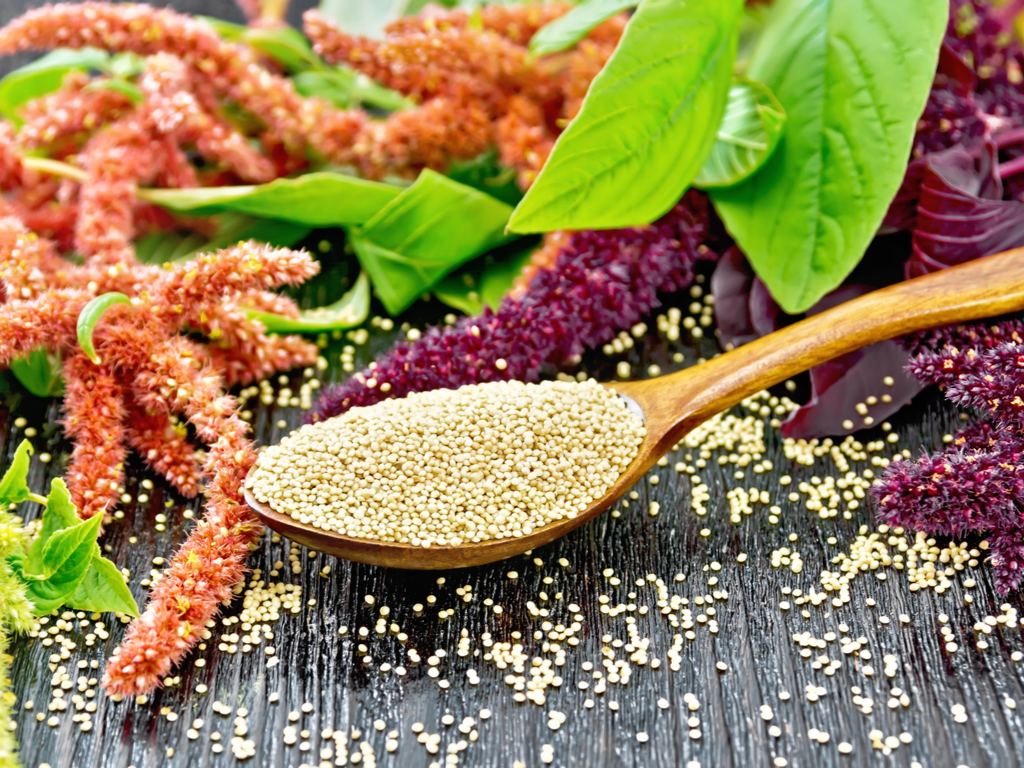
Kiwicha (or Amaranth)
Kiwicha, also called amaranth or miniature quinoa, easily makes the Peruvian superfoods list. It’s effortlessly one of the healthiest and most popular superfoods in South America.
It has been cultivated in Peru for over 4,000 years! You’ll see it grown in the Andes mountains at elevations reaching 12,000 feet.
What it Tastes Like:
Amaranth tastes very similar to quinoa with a slightly nuttier flavor.
Nutrition Facts:
Kiwicha, or amaranth, is highly nutritious! Just one serving of this Peruvian superfood packs on over 9 grams of plant-based protein, healthy carbohydrates, essential fatty acids, and a lot of fiber (over 20% of your daily value).
Vitamins and Minerals include:
- Manganese
- Magnesium
- Phosphorus
- Iron
- Selenium
- Copper
Health Benefits:
Kiwicha is a good source of health-promoting antioxidants. It has also been found to reduce chronic inflammation that leads to diseases like cancer, diabetes, and even autoimmune disorders.
It may help lower cholesterol levels, aid in weight loss, and is naturally gluten-free.
How to Use It:
This seed can be utilized in many recipes and everyday products. It can easily take the place of rice in any dish or be added to soups, stews, and even pancakes.
Where to Try it While in Peru:
While in Peru, you’ll see it being sold in both seed and powder form. It’s used a lot for baking bread and pasties all throughout Peru.
Some very popular Peruvian breakfasts are prepared with Kiwicha, which can be found in cafes and even street vendors in the morning.
See also:
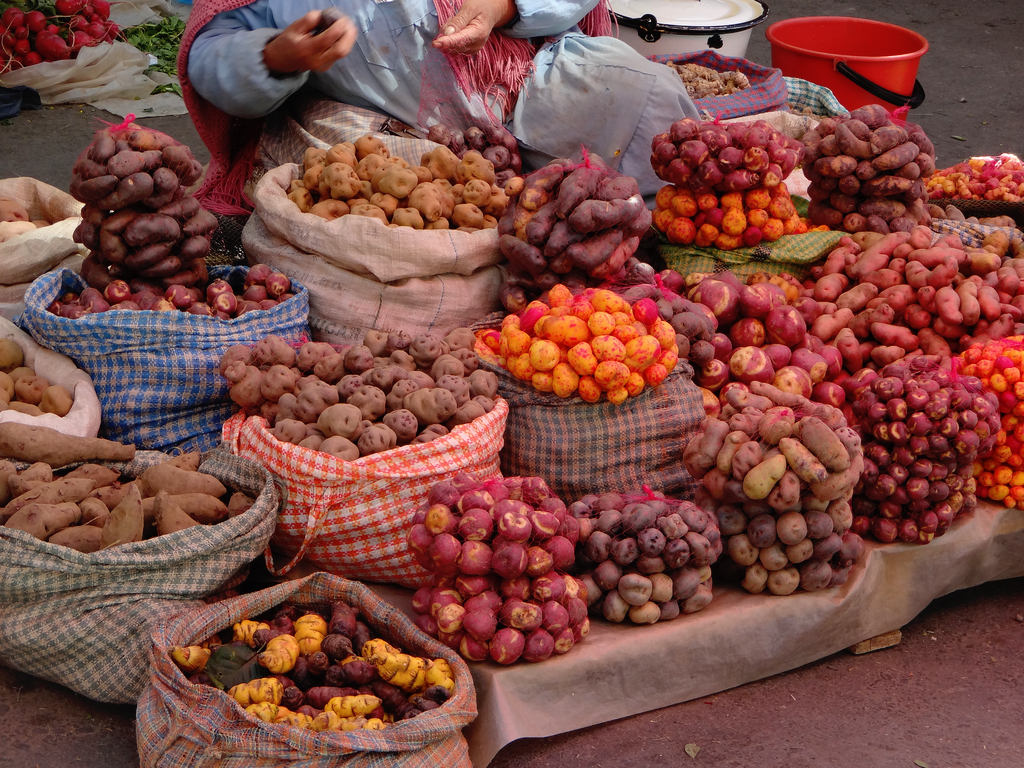
Papa Peruanita (aka the Purple Potato)
With more than 4,000 varieties of potatoes in Peru, it’s not a surprise that this vibrant vegetable would make the Peruvian superfoods list.
The Peruvian purple potato is distinctive from the rest because it’s exceptionally rich in antioxidants and anthocyanin.
It’s believed to be grown as long as 13,000 years ago, high in the Andean highlands of Peru. It’s even thought to be a popular delicacy within Peruvian royalty centuries ago during the height of the Incan empire.
What it Tastes Like:
They have a denser texture than your regular white potato. They’re also slightly nuttier and more “earthy” than white potatoes. And they certainly add a beautiful pop of color to your plate.
Nutrition Facts:
Purple potatoes are a healthy addition to your diet, as they are high in complex carbohydrates, fiber, and even protein.
Their vitamin and mineral content include:
- Manganese
- Copper
- Iron
- Vitamin B6
- Vitamin C:
- Potassium: Believe it or not, this variety of potatoes contains more potassium than a banana!
Health Benefits:
Eating purple potatoes is an excellent alternative to yellow or white potatoes because they have less effect on elevating blood sugar levels.
They’re also rich in antioxidants and contain anthocyanins, known to improve eye and heart health.
How to Use It:
You can prepare purple potatoes similarly to preparing white or yellow potatoes. I personally like to use them in my buddha bowls to add some vibrant color!
Where to Try it While in Peru:
In the United States, you will most likely pay more for an imported purple potato in the supermarket.
In Peru, however, they’re literally everywhere! If you’re in Lima, head over to Maido. It was voted the Best Restaurant in Latin America in 2017! Be sure to order the purple potato cream-filled dumplings. You won’t be disappointed!
If you enjoyed this post, please pin me!
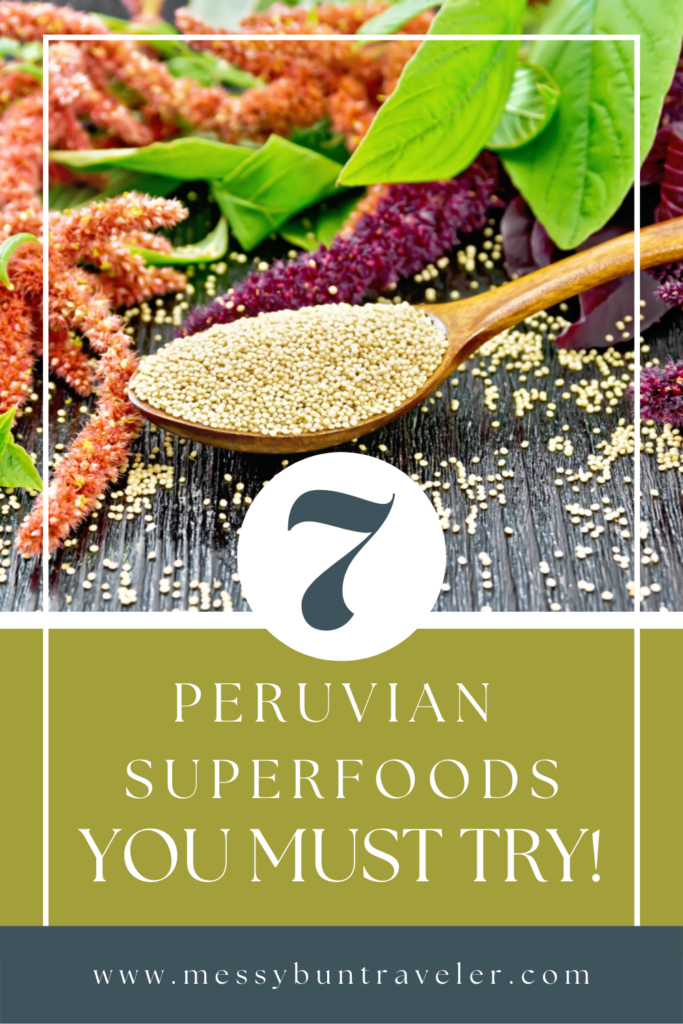
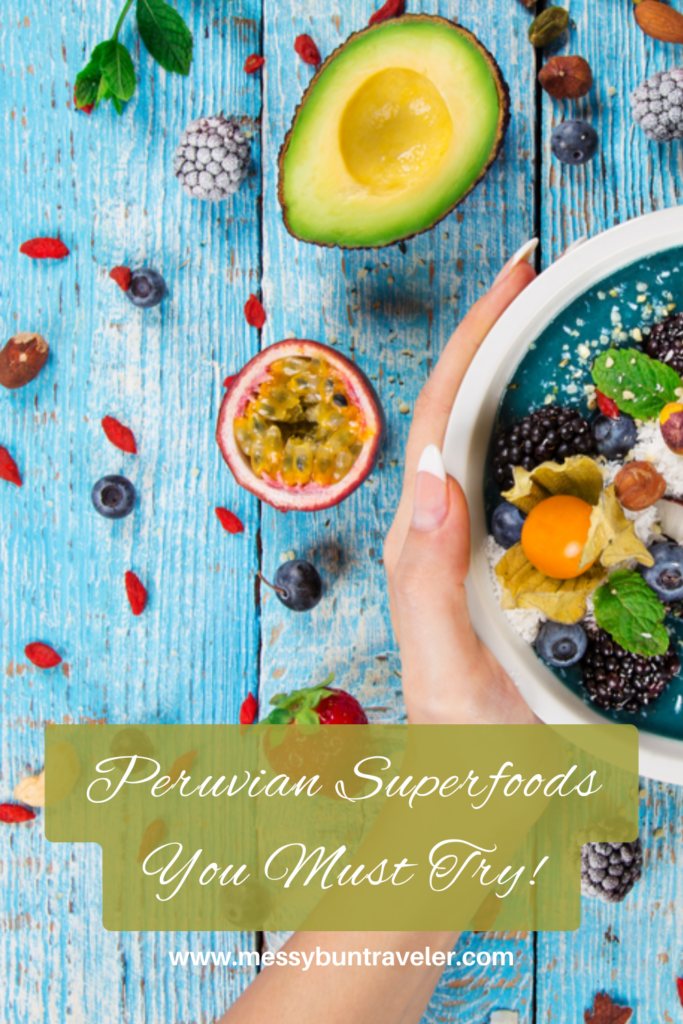
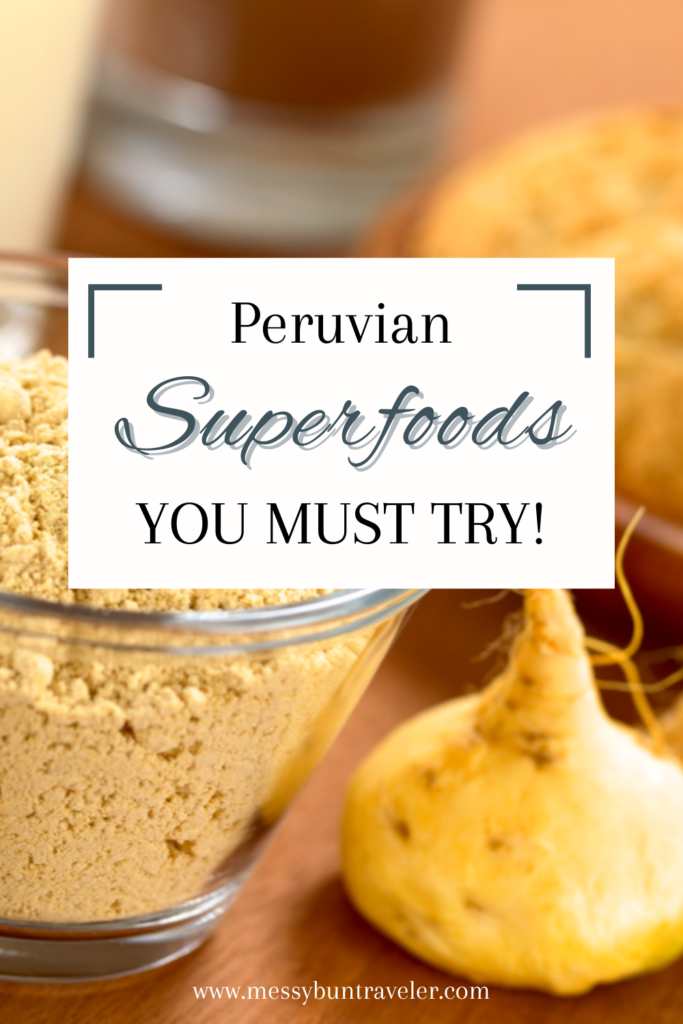
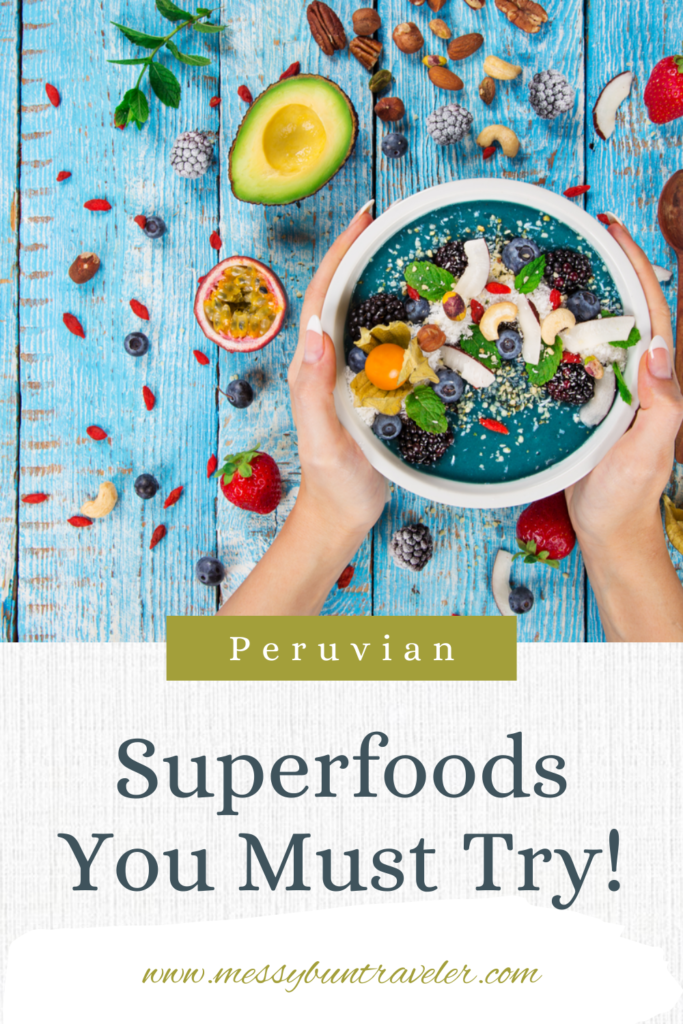
Join my newsletter
* We will never share your details with any third party